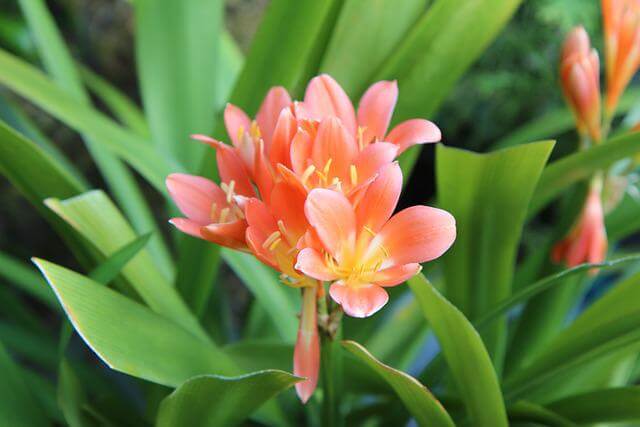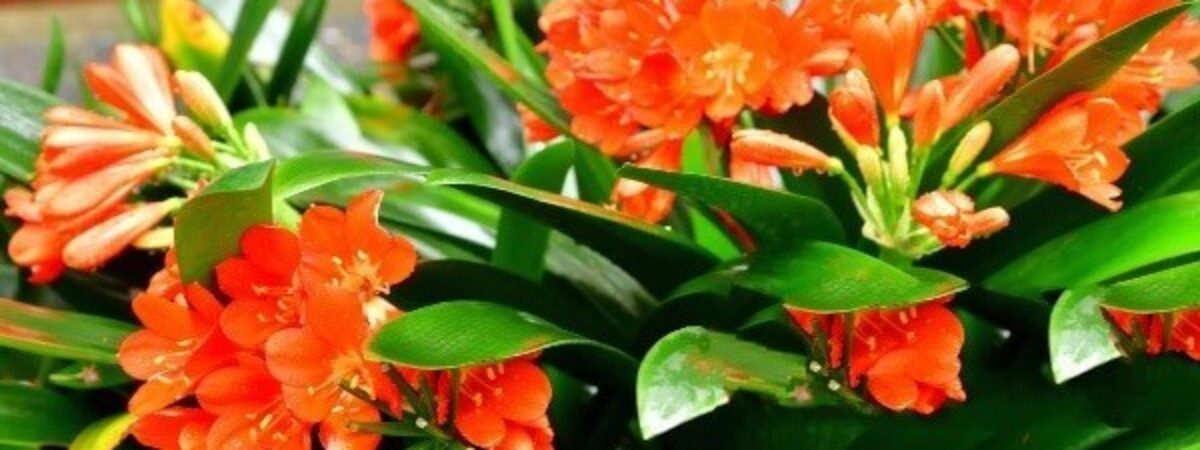Clivias are luminous and lovely flowering plant that blooms on a gloomy winter’s day as they shine like little beacons of orange, red, yellow, and cream under the shade of a tree.
This beautiful plant arrives just when people need them the most, just after the craziness of the holidays has settled down and the cold of winter has settled in.
These unusual clivia plants got their name from the Lady named Florentina Clive and these plants are so exquisite that they fetch a hefty price like $50 or more per plant.
Don’t you want to bring this exquisite, beautiful plant to your home? Don’t want this showy flower to enhance the beauty of your house and garden?
Then let’s dive into the article to learn the growing and caring guide of the clivia plant.
Plant overview
Clivia otherwise named the natal lily is a beautiful flowering houseplant that brings a gold feature to your home and garden. This showy, frost tender, and beautiful plant bear stocky stems topped with large, rounded heads of colorful flowers, from late winter to spring.
Being originated in the woodland of the country of South Africa, this beautiful plant is often referred to as the forest lily.
Clivia otherwise named the natal lily is a beautiful flowering houseplant that brings a gold feature to your home and garden. Click To TweetThe foliage of clivia is architectural and attractive all the year-round, with wide, dark green, strap-shaped evergreen leaves growing from a swollen, fleshy root. The Flowerheads of this plant are made up of eight to ten bell-shaped blooms, usually in shades of orange, yellow, and red.
Clivia can live for many years with a height of 45 cm and width of 30-40 cm. When it comes to toxicity, clivia is mildly toxic in nature. It may harm your pet as well as the sap of the plant can make skin irritation and eating any part of the plant can cause mild stomach upset.

Varieties of clivia plants
There are a lot of varieties of clivia plants found in the world that a gardener can grow as houseplants or outside in their gardens in the right climate. Listing all the varieties of clivia is an overwhelming task.
But here are some of the popular varieties of clivia you must know
Clivia caulescens:
This variety of clivia is an evergreen variety of the flower that grows in a tube-shaped flower drooping down from the plant’s central stalk.
Clivia Gardenii:
Clivia Gardenii is a perennial flower variety that grows in a slight trumpet shape in shades of red and green.
Clivia Miniata:
Clivia Miniata is a popular variety that is short and funnel-shaped and grows in shades of yellow, red, and orange, with deep green foliage.
Clivia Mirabilis:
This variety of clivia is the most recently discovered. It bears flowers that are long and trumpet-shaped and droop from their central stalk.
Clivia Nobilis:
This type of clivia bears a larger bush of long pointy foliage, in which the clusters of hanging flowers grow with green ends.
Gardeners are advised to plant clivia flowers from late winter to early spring to make the most of this first active season that lasts from spring to fall. Click To TweetClivia robusta:
Clivia robusta variety grows in the season of late fall to mid-winter and boasts flowers that arch out from the tall stalks. This variety is the tallest growing variety of clivia, that grows up to five feet tall.
When to plant your clivia plant?
Gardeners are advised to plant clivia flowers from late winter to early spring to make the most of this first active season that lasts from spring to fall. If you are considering planting your clivia in the ground, Keep in mind that you should only plant if you live in USDA hardiness zones 9 to 11.
If you are residing in a colder place, you should plant clivia in a pot. If you are repotting your plant during the winter, make sure to keep your plant indoors until spring.

Where to grow clivia?
Being a houseplant, clivia can grow in a house environment, in a conservatory, or in a greenhouse condition. It is recommended to grow this plant where the temperature is low up to 5°c. Otherwise, the plant can show the symbol of frost damage.
If you are looking for a proper place to plant clivia, consider planting it in bright, indirect light and avoid placing it near a hot place. In summer, it can also be placed in the garden in a sheltered place out of direct sunlight.
How to plant your clivia plant?
If you are considering planting your clivia plant from seeds, it can be quite tough for you. As growing clivia from the seeds is a time-consuming process, you may wait for several years to see your plant blooming with flowers.
So it is always recommended to grow your clivia plant from the offsets. Growing the clivia plant from the offsets involves the following steps.
- Choose a proper location for planting your clivia. First, decide yourself where you want to grow it. Whether you want to grow it indoors or outdoors.
- Clivias prefer indirect light and partial shade. So if you are planting it outdoors, choose a location that is out of the direct sun.
- Before you plant your clivia offset, choose a good quality potting mix of soil with a little peat moss or sand in it for the proper growth of the plant. This mix helps you to loosen and make sure that it is well-draining which can help you avoid root rot.
- Once you have filled your container with the right and appropriate potting mix, dig a hole larger than your plant’s fleshy roots.
- Then gently remove the offset of clivia from its parent plant and place it in the hole in your soil.
- Cover the roots of the offsets with additional soil and water immediately, and check the base of the container to ensure the water is draining properly.

Caring guide of clivia
Water
Clivia plants do not like too much water, as too much watering can cause root rot. So it is recommended to water your plant sparingly. Allow the soil to dry completely for a few days between waterings to make sure that you’re not waterlogging your plant.
Soil
Clivia prefers a well-draining soil that has a lot of peat moss and some sand to prevent the roots from staying too wet.
Light
Clivia plant requires bright, indirect light to grow but it may die in direct sun. The direct sun scorches the leaves of the plant and ruins its beautiful flowers.
During the summer, a Clivia tends to grow outside as long as you keep it in the shade out of direct light.
Temperature
A Clivia Plant thrives well in temperatures between 65°-70° F during the season of spring, summer, and early fall. From November to February, when your Clivia plant is “resting”, it prefers the temperature to be 50°-55. A Clivia plant can’t grow well below the temperature of 50° F.
Humidity
When it comes to humidity, an average household humidity is adequate for a Clivia.
Fertilizer
Clivia plants don’t like too much fertilizer. It enjoys being fed using organic fertilizer. It is recommended to feed your clivia plants once a month.
How to propagate a clivia plant?
A clivia plant can be propagated from seeds or by cutting off outer sections of the plant, known as offsets. Propagated clivia plants can take up several years to produce flowers.
Propagation from the seeds can be done by the following methods.
- Collect the seed of the berries of clivia when they turn red.
- Sow the seeds in individual small pots of moist seed compost and place them in a warm spot.
- The seeds will start germinating within two months.
Propagation from the offsets can be done by the following procedure
- Detach the offsets of the clivia from its mother plant using a sharp knife. Ensure that the offsets should have roots in them.
- pot up the offset either individually or with several offsets in a large pot.
- Take the proper care as recommended.
Conclusion
As you have read the article this far, you might have got all the required details to grow and care for it in your house.
Just imagine the sunny orange blossoms on your Clivia plant contrast nicely with the bleak landscape outside your window this time of year and give hope for spring.
Don’t you want this to happen with you in real life? Then why delay?
Bring an exquisite, beautiful, showy Clivia plant to your home and add beauty to your home and garden.
You may also like to read
How to grow and care for Dahlia flower plant- A step-by-step guide






